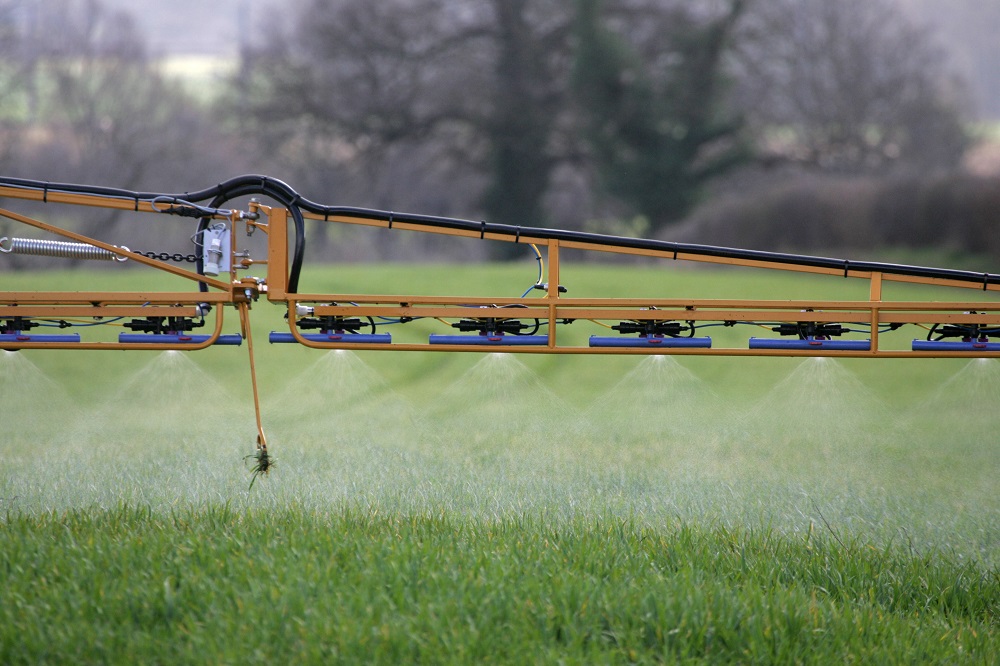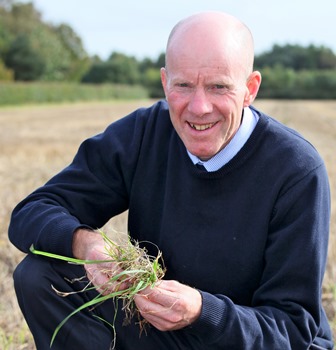In the third of our ‘5 for 5’ series to beat blackgrass, CPM asks Dr Stephen Moss how to get most from herbicides and we gather the latest advice from across the industry.
Flufenacet is rightly regarded as the backbone of the pre-em programme.
By Lucy de la Pasture
The answer to blackgrass problems may no longer come in a can but herbicides still have an important role to play as part of an overall control strategy. But to wring out every bit of herbicide performance while not compounding problems for the future requires some pertinent questions to be asked, believes Dr Stephen Moss.
Are you destroying all weeds effectively prior to sowing the crop? And if not, why not, he asks.

Stephen Moss questions whether reliance on an ever-increasing stack is a sensible strategy in the long term.
“Applying glyphosate pre-sowing is probably better at killing weeds than relying on cultivations. How many stale seedbeds to use before planting is debatable. Although there’s no evidence of glyphosate resistance in the UK blackgrass population, the risk is there. It would be a great loss if we lost glyphosate so we need to be careful with it,” he says.
Rothamsted’s Dr Paul Neve agrees, “The key message is that whilst glyphosate is becoming an increasingly important tool for chemical control of blackgrass, we have to be minded that increasing usage on stale seedbeds has attendant resistance risks. This has been shown previously in Australia where ryegrass, resistant to most other herbicide modes of action, was increasingly being controlled in no-till systems with heavy reliance on glyphosate. Glyphosate resistance evolved.”
Monsanto’s Barrie Hunt advises that we shouldn’t ignore the threat of resistance development in ryegrass. “We get very hung up about blackgrass but effective management of glyphosate in all annual grasses is critical.
“Stephen’s ‘5 for 5’ initiative clearly shows we already have all the tools to control blackgrass but haven’t been using them. Some herbicides aren’t as robust as they used to be, but there are many elements to a weed control programmes so it’s important not to continue down the ‘herbicide junkie’ route,” he believes.
Most of the issues with poor control from glyphosate Barrie sees are where it’s been applied to stubbles, which he believes don’t always get the same level of care and attention in application because they’re not regarded as a crop.
“The temptation is to rush the job, increasing pressure and forward speed when spraying stubbles, resulting in poor delivery. It’s one of the very few chances to achieve good control of blackgrass with a herbicide, so attention to details is every bit as important as it would be if the crop were already planted.”
Current advice to minimise the risk of resistance is to apply two applications of glyphosate with sufficient cultivation to kill survivors and effective subsequent herbicide use. Multiple applications in the absence of sufficient cultivation should be avoided, he says.
“Target weeds at the 2-3 leaf stage to get the best results. Any earlier and germinating weeds won’t be hit, any later and an increased rate will be needed if control is to be maintained. A rate of 540 g/ha of glyphosate should be adequate in the autumn but for stale seedbeds after the winter, with well-tillered blackgrass and ryegrass, the rate needs to be increased to 720 g/ha,” advises Barrie.
The second prong of herbicide attack currently relies on a stack of residual actives, applied pre-emergence of the crop and weed. With the increasing loss in efficacy of ACCase and ALS post-emergence herbicides due to resistance, the pre-emergence programme has become the mainstay of the herbicide strategy.
Stephen believes that pre-em herbicide use needs to be rational and questions whether reliance on an ever-increasing stack is a sensible strategy in the long term.
“Flufenacet is rightly regarded as the backbone of the pre-em programme, but we’re seeing the dose of flufenacet frequently being ‘topped up’ and an over-reliance on the active.”
Although the efficacy of flufenacet has stood up well, it’s not immune to enhanced metabolic resistance (EMR). This type of resistance builds up slowly but if more and more of a single active ingredient is applied, this will almost inevitably result in an increase in EMR, reminds Stephen.

Boom height is the single most controllable factor during application and it makes a big difference to the efficacy of herbicide being applied.
Frontier’s David Robinson agrees that more thought needs to go into protecting actives. “Flufenacet is the most effective on blackgrass so people are using more, topping up 240g/ha to 360g/ha. This is just putting more selection pressure on flufenacet.
“Looking forward, new active residuals are going to be in scarce supply so we need to look after the ones we already have,” he adds.
Stephen points out that pre-ems can’t be relied upon to perform consistently. “My other worry with the pressure on pre-em herbicides to provide the bulk of blackgrass control is their dependency on soil moisture to work well. This intrinsic variability, along with increasing EMR, means that their activity is going to be inconsistent year to year, with poorer performance likely in dry autumns. However, there is evidence that Avadex (triallate) is less affected by dry conditions than other pre-ems.”
“The trend towards non-inversion tillage introduces an additional variable into the equation because organic matter residues in the surface layer of soils will adsorb herbicide, preventing some of its uptake by blackgrass roots,” he adds. “Increasing organic matter is ‘good’ of course, but the one downside is a potential reduction in efficacy of residual herbicides – and even modest levels (~5%) of organic matter may have an impact.”
Mix of actives
The mix of actives in the pre-em herbicide stack is something that Stephen believes growers are best-placed to discover themselves by experimenting on their own farm.
“Results from trials on other farms, with different soil types, organic matters and resistance, may be misleading,” he believes.
Post-emergence herbicides may not bring so much to the party these days where blackgrass control is concerned, but there are other considerations before abandoning using them, says Stephen.
“Know what you’re getting from a post-em and accept you may be getting very little on blackgrass. But since the use of Atlantis (iodosulfuron+ mesosulfuron) has declined, ryegrass, bromes and wild-oats have become more evident so don’t be ‘blinkered’ by blackgrass alone,” he says.
Stephen also recommends reassessing the value of older active ingredients (eg clodinafop) with mixing partners, but recognises that timing is critical and re-registration concerns means that this is not a priority area for agchem companies.
“Make good use of products with alternative modes of action in the non-cereal crops, such as carbetamide and propyzamide, to optimise blackgrass control in the rotation. There’s very good global evidence that clethodim isn’t as badly affected by resistance as other fops and dims but be careful not to overuse it in other crops because it isn’t immune to resistance,” he warns.
One of the things Stephen advocates is resistance testing rather than assuming that’s what the problem is with poor control. “Testing is particularly important in areas where blackgrass is only just appearing – if it’s been imported in crop seed, straw or equipment it may already be resistant even if blackgrass herbicides have never been used. Re-testing is also important so you know exactly what you’re dealing with and can amend herbicide strategies accordingly,” he stresses.
Often resistance is presumed, agrees David. “Many things can affect the efficacy of herbicides so it’s important to get a test done. Often when blackgrass is first seen on the farm there’s an assumption that resistance has been imported with it, but this isn’t necessarily the case.”

David Robinson believes in-field testing for EMR in blackgrass will prove a useful tool in the near future.
Frontier is looking at an in-field test for EMR resistance at its Staunton blackgrass site which may prove to be a useful tool. “At Staunton, the blackgrass has moderate EMR and high target site resistance. Knowing the level of EMR in a blackgrass population can help indicate the performance of the stack,” notes David.
Selection of herbicides is only part of the equation. Getting a lethal dose of active onto the target at the right time is equally as important but sometimes overlooked, especially as spray windows get tight.
Syngenta has been looking at integrated blackgrass control at its Barton Innovation Centre, explains the company’s herbicide campaign manager, Mel Wardle.
“Pre-em applications are more prone to drift because bare soil is the target. Application is made at a time when soils are still warm but the air temperature is cooling. This causes rising air from the soil surface which can carry fine spray droplets away from the target,” she explains.
To counter this effect, there are four key principles to get right during application. “Don’t travel at speeds above 12km/h. The faster the forward speed, the more turbulence is created behind the boom and boom stability decreases, leading to higher levels of drift.
“Boom height is the single most controllable factor during application and it makes a big difference to the efficacy of herbicide being applied. Trials results at Barton showed 65% control of blackgrass at a boom height set at 100cm, compared with 80% control at a height of 50cm above the target,” she says.
Even small additional percentages in blackgrass control are of utmost importance in reaching the Holy Grail of 97% control needed to prevent the problem from worsening in subsequent seasons, points out Mel.
“We looked at water volume and found that 200 l/ha gave better coverage than lower volume applications. A coarser droplet size is also desirable to reduce drift so it’s important to use the appropriate pressure, too high and you’ll get more fines and more drift,” she points out.
“For those using 3D-nozzles, these remain an excellent choice but can be more sensitive to drift. We recommend that if conditions aren’t ideal, the Teejet TTI 90% drift reduction nozzle should be used. These produce a coarser droplet spectrum and are comparable to application through a 3D-nozzle in terms of efficacy.”
DuPont’s Alister McRobbie believes the ‘5 for 5’ initiative makes the important point that blackgrass control strategies should be adapted to each individual field situation, there’s not a cross-farm blueprint. He emphasises the importance of timing sprays well.
“Often delays in application of herbicides can result in inferior levels of control, as blackgrass has grown too large. With delayed drilling, you can spray-off germinating blackgrass before drilling and generally in Oct, temperatures are lower and there’s more soil moisture, so pre-em and early post-em components of the residual stack invariably work better.
“Seedbed quality also has implications for herbicide activity and blackgrass germination. Cloddy seedbeds will hamper weed control and when the clods break down later in the season, they will often release blackgrass seed, which then germinates,” he says.
David sums up by pointing out it’s no good doing the same thing and expecting to get a different result where blackgrass is concerned. “There isn’t a short-term fix and you need to involve as many of Stephen’s 5 for 5 strategies as possible. But there’s a game to win and that requires sticking to the commitment of 5 for 5.”
Building the stack

Applying herbicides at the peri-em timing is less reliable than at the true pre-em timing, says Gordon Anderson-Taylor.
It’s important that herbicides are the ones best suited to the situation on the farm. The challenge is identifying the most appropriate products, says Dr Gordon Anderson-Taylor of Bayer.
“Replicated trials on farm are the gold standard but this isn’t an option for every farmer. For most people fighting blackgrass, the challenge is to use the information that’s already out there and consider a strip trial on farm when there’s an important question that you can’t find the answer to elsewhere.
So how do you choose which herbicide as the base of the stack? Liberator (flufenacet+ diflufenican) and Crystal (flufenacet+ pendimethalin) are two of the main pre-em herbicide products but there’s a debate over which performs better. Performance can vary from farm-to-farm and is probably due to soil chemistry, although there has been no research into it, says Gordon.
“Results from last year showed very similar performance between Liberator and Crystal but with site to site variation, as has been the case in other seasons. If you’ve spotted differences on the farm between the two then it’s worth considering these before choosing the pre-em.”
Should application be pre- or peri-emergence? The typical recommendation is to apply residual herbicides within 48 hours of drilling to get the best efficacy, comments Gordon. Sometimes circumstances mean the herbicide is applied much later but how much effect does this have on performance?
“At the peri-em timing, performance is less predictable. If you’re lucky it will be almost the same as true pre-em, but there’s the danger of losing 30–50% control. Last season, Liberator gave about 5% less total control at peri- than at pre-em – so not enormous but enough to make a difference and one that would almost certainly be greater in a more challenging season. With blackgrass being such a difficult weed, once you have invested in a herbicide it pays to apply it at the best time to get full benefit.”
Syngenta’s Mel Wardle adds that although flufenacet is widely used as the base to programmes, it’s important not to rely solely on one active and this is where Defy (prosulfocarb) comes in.
“In trials, the addition of 4 l/ha of Defy to a Liberator programme has given an extra 20% in levels of blackgrass control, providing useful support to flufenacet and offering a different mode of action,” she says.
A relatively novel post-em addition to the residual stack is Xerton (ethofumesate). Falling into the same group of chemistry as triallate and prosulfocarb, the active also offers an alternative mode of action to flufenacet-based products and has no known resistance, says Simon Fisher of UPL.
“Xerton brings additional blackgrass control of between 9-25% according to trials by NIAB-TAG, where actives are compared over a base application of flufenacet.”
For best results, Simon recommends application pre-emergence of the blackgrass. “Uptake is by the coleoptile so you need to get Xerton on early, in the same timing slot as DFF and prosulfocarb. The ethofumesate provides useful activity on annual meadow grass, brome and wild oats, with additional control of chickweed, shepherds purse and ivy leaved speedwell,” he says.
The current label recommendation is for a post-em application from GS12 of the crop, but there’s an application for pre-em use currently being considered and it’s anticipated it will be on-label in 2018, says Simon.
On-farm trials invaluable
The key to controlling weeds on your own farm is understanding what you’re dealing with, and that means species and resistance status, says BASF’s Ruth Stanley.
“Looking at where they’ve come from – contractor’s or your own machinery which hasn’t been cleaned between fields, or imported from muck – is also a valuable process. Then where do the weed seeds sit in the soil profile? Is it shed seed from the last crop left on the soil surface, mixed through the soil from cultivations or buried below the germination zone through ploughing?
Once you have a good understanding of what you’ve got, you’re better able to deal with the problem and understand what works for you in your own farm situation to find a solution, she advises.
“Completing trials on your own farm is the best way to build a blackgrass strategy which will work for the long term, as you’ll need to work on reducing seed numbers in the soil for at least two or three years before real differences can be achieved.”

Ruth Stanley has conducted trials on her own farm to help find the best active ingredients to use on her resistant blackgrass.
Ruth believes cultural and chemical controls must be used in partnership to achieve results. “The correct cultivation technique will depend on where weeds seeds are buried by previous cultivations but principles of late drilling, stale seed beds and competitive crops will apply to everyone.
“Proper consideration needs to be given to all chemical applications. Product choice is important but so is how it’s applied. Seedbeds should be moist and clod free to allow the chemical to do the best job it can, spray application needs to ensure complete soil coverage through correct boom height and sprayer speed,” she comments.
“Pre-em sprays should always be applied in a blackgrass situation and by pre-em, I mean within 48 hours of drilling. Stacking different modes of action will achieve the best results and form part of an anti-resistance strategy. Choose quality products at appropriate rates, if you’re dealing with blackgrass it’s not the time to cut corners.”
Flufenacet is the backbone of any blackgrass chemical control programme but generic products can be inconsistent. In BASF and independent trials, a programme of Crystal plus DFF at pre-emergence gives reliable efficacy and the best start to blackgrass control, she believes.
“As a farmer on heavy land I have to deal with blackgrass myself. We’ve had to work hard with cultural controls to reduce seed return, then used on-farm trials to understand what works best for me. It’s made a huge difference to the levels of blackgrass on the farm, but also made me realise you must keep up the pressure on blackgrass control because it will return as soon as we let it.
“Spring cropping and spraying blackgrass off in standing crops before it seeds, have been key to reducing the blackgrass seed burden we have at home. Using Avadex granules (triallate) on the drill and following with 4 l/ha of Crystal plus 0.2 l/ha DFF has given good levels of control.
“We follow post-em with a pendimethalin top up, using either Picona (pendimethalin+ picolinafen) or Stomp Aqua (pendimethalin), if we need to. With confirmed blackgrass resistance on farm we try not to use Atlantis, but deal with the problem before it gets to that stage,” says Ruth.
5 for 5 to beat blackgrass
A two-page leaflet has just been produced by Stephen Moss Consulting summarising the 5 key control measures which should be used for 5 years on individual fields to really get on top of black-grass: Stop seeding, Cultivation, Sowing date & rotations, Competition; Herbicides.
An electronic version is available on the Croprotect website – look in the ‘Weeds’ section. Limited quantities of hard copies of this leaflet are also available directly from Stephen Moss at alopecurus@aol.com.




